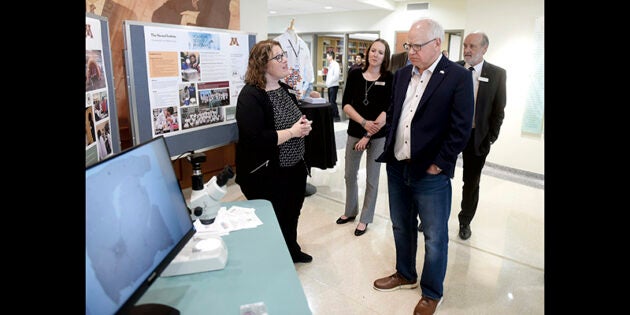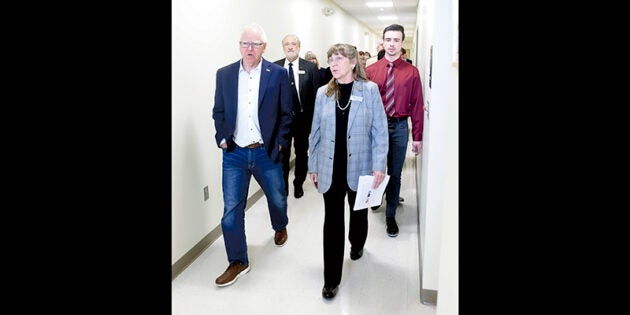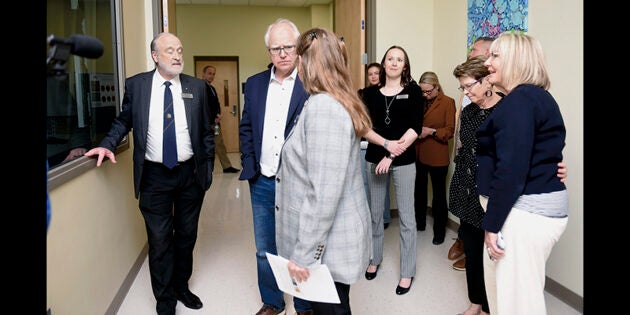Walz praises Institute expansion project during Thursday visit
Published 6:56 pm Thursday, April 25, 2024
|
Getting your Trinity Audio player ready...
|
As part of an expanded trip to Austin on Thursday, Gov. Tim Walz visited The Hormel Institute to learn more about recent efforts to expand the facility’s bioimaging capabilities as well as its expanded educational efforts.
The Institute is hoping to secure $20 million in bonding money from the state legislature, pushed in bills by both Sen. Gene Dornink and Rep. Patricia Mueller, that will go toward its Minnesota Bioimaging Center (MBiC) expansion.
The estimated cost of the first phase of this project is around $50 million.
This expansion will not only add to its already impressive imaging reach through the use of its cry-electron microscopy (Cryo-EM) capabilities, but its added cryo-electron tomography capabilities (Cryo-ET) as well.
Later this year, the Institute will be the first institution in North America to obtain the Arctis focused ion beam scanning electron microscope that will expand the Cryo-ET ability.
Another part of this is the education component, not only in the industry but among students and schools as well. The whole package was something that stood out to Walz.
“I just think this focus on spreading the education and the ability of workforce training, and this idea that no one else has the workforce to deal with the equipment, let alone the work it can do — I think just some of the results of what they are talking about with this imaging was really helpful during the pandemic,” Walz said. “I think this is going to be the future. It fits with our goals.”
Walz first met with Institute and local leaders about the future before taking a tour of the facility to learn more about what that future might hold.
Walz said this kind of consolidated effort is what is going to put the Institute and by extension the state, on the larger map of medical science.
“When I come to a place like this and see the intersection of local, state and federal and then you see public and private partnerships in building something like the building we’re in … it’s an exciting time,” he told an assembly at the end. “This idea of what the future of Minnesota looks like — It looks a lot like what you’re doing here.”
Walz has been a strong supporter of the Institute’s prior expansions in both 2008 and 2016, as well as supporting this most recent attempt.
Having him on site is a step forward for Institute officials who see this MBiC expansion as a benefit not just for Austin, but regionally as well.
“I think it resonated very well,” Executive Director Dr. Robert Clarke said of Walz’s visit Thursday. “This is a state wide, region wide project that serves so many people directly because of collaborations and research, and indirectly the products of that research that will eventually lead to improvements in human health. We’re happy and it was wonderful to have him back.”
Earlier in the day, Walz was part of a groundbreaking for the Interstate 90 bridge project and while on the surface the two projects seem different, Walz said they are actually connected in creating a lane of medical advancement in the country.
“There’s no doubt it’s all part of that interconnected hub; medical alley,” he said. “It makes us a world class destination. In the United States it really is Boston, San Francisco, Austin, Texas and us. I think another crown jewel like this really sets us apart. I’m enthusiastic about it.”
“They are absolutely tied and I would argue our investment in child care is a part of that,” he continued. “Our investment in education, our investment in ending childhood hunger — they are all tied together.”
As the Institute continues hoping for the needed bonding money, Clarke said that having Walz on site to see what the institute plans is important to fully grasp the scope of the project. At the same time, though, it has other advantages.
“It makes a huge difference,” he said. “First and foremost it lifts the morale and reminds everyone here that what they do here is understood and appreciated by others. That we don’t just live and work in a bubble.”








